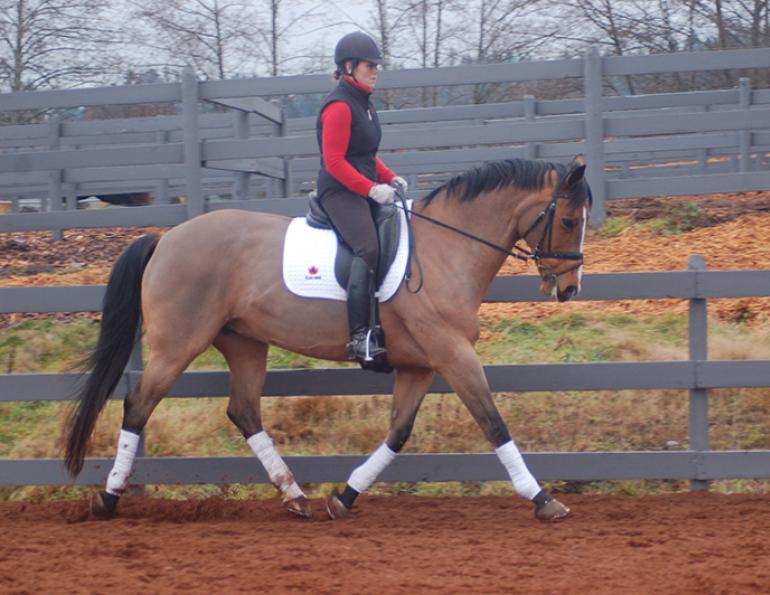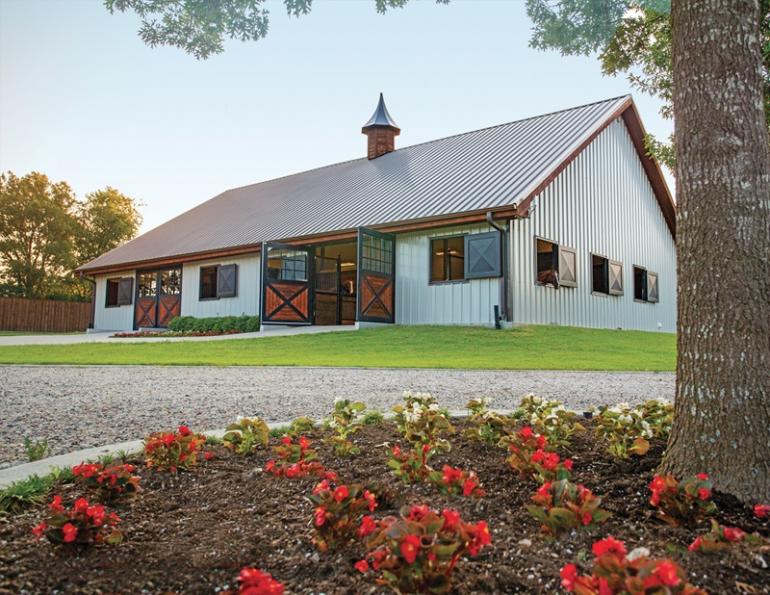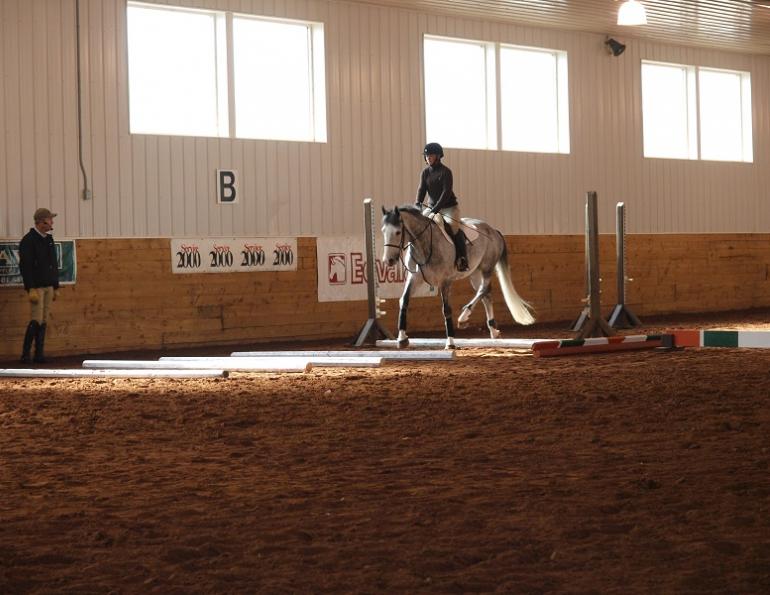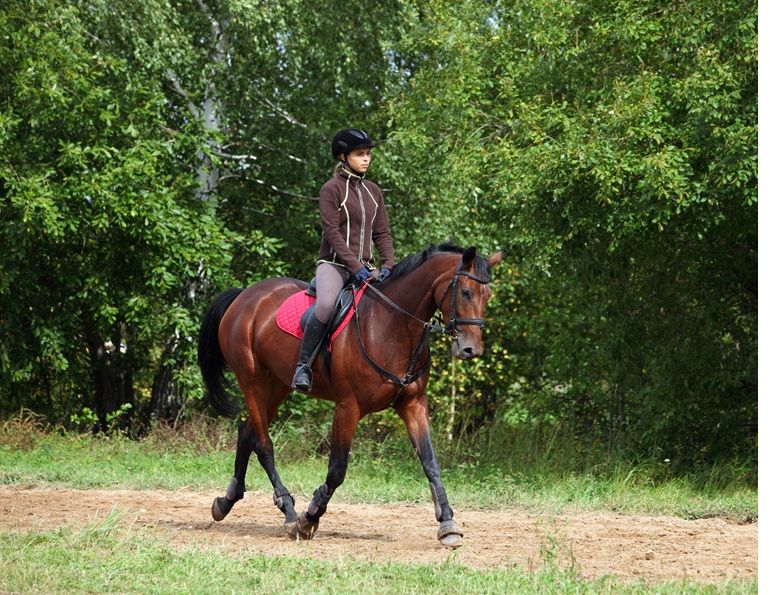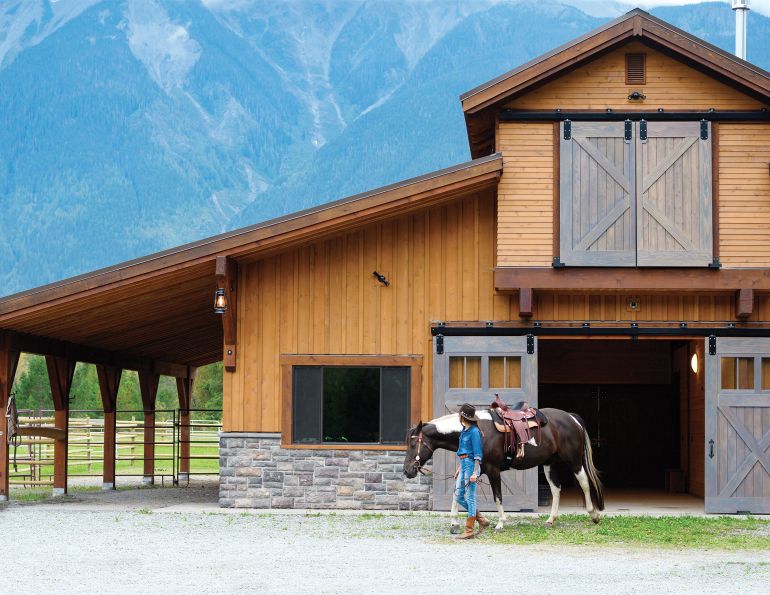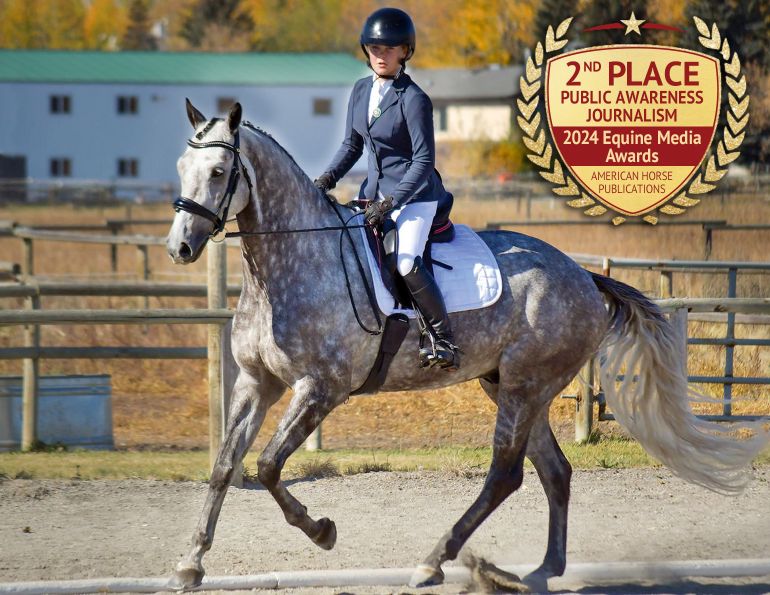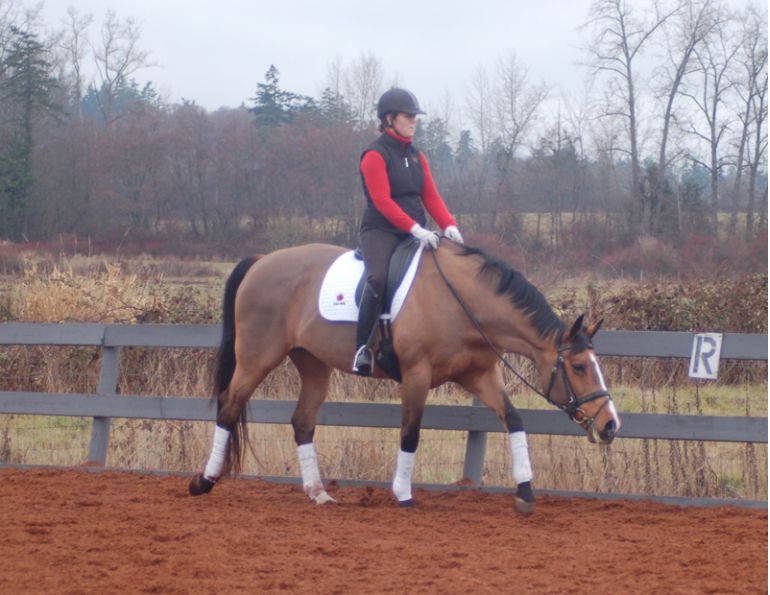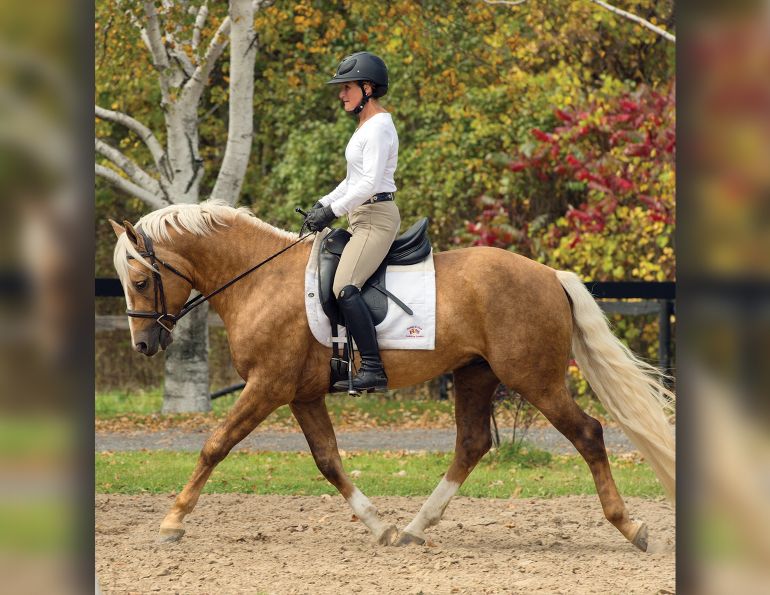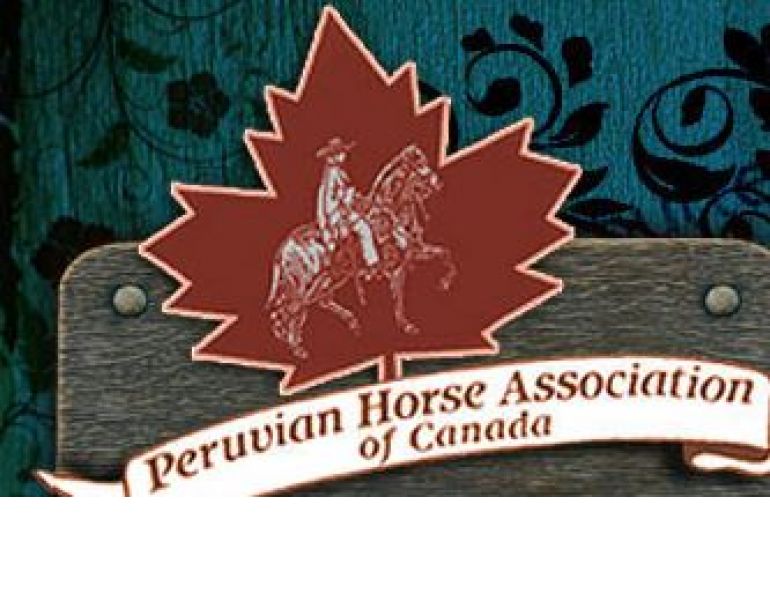By Jess Hallas-Kilcoyne
In "Starting Out on the Right Foot: Warm-Up, Part 1", we covered the general principles of a good warm-up and the reasons why it’s an essential part of every ride.
Now we’ll continue to focus on the warm-up with a look at some basic exercises designed to prepare your horse physically and mentally for the workout session
EXERCISES FOR DRESSAGE HORSES
Shannon Dueck has been a force in the international dressage ring since 1995. Aboard Korona, she claimed an Individual Silver Medal at the 1999 Pan Am Games, and is now declared for the 2012 Olympic Games with Ayscha. Dueck has trained with coaches such as Bert Rutten, Lars Peterson, Hubertus Schmidt, and most recently, Carl Hester.
From the moment she gets on a horse, Shannon Dueck’s priority is to instill in her mount the reactions that will be required during the workout portion of her ride. This, as well as warming up the horse’s physical body, is the focus of her warm-up.
The most important thing, “regardless of the horse, is the forward reaction to the leg,” says Dueck. “Without it, there’s no point in going onward…horses that are naturally more forward will be easier; the colder horse that’s more phlegmatic will take a bit more work.”
Dueck begins each ride with about ten minutes of walk on a loose rein, followed by trotting large around the arena, focusing on riding the horse forward without rushing him. “The most important exercise for forward is going large. To get them forward from the leg easily is the priority.”
“Once I can put my leg on and have the horse react immediately, from that I take contact with the rein,” she continues. “The horse has to take contact…going forward into my hand. The horse must be confident going to the bit and taking a connection.”
Once the horse is moving forward into the contact, Dueck checks to make sure that he is balanced. “The horse needs balance before it can be relaxed. The best exercise for balance is forward and back. I do a lot of that in the warm-up. Forward is about riding the transition, closing my leg, and expecting an immediate reaction. When I try to create more balance, coming back is really important…I always tell my students to do transitions within the gait.”

Photo: Darlene Brain
Forward and Back
Begin trotting large around the ring in an active, working trot. Coming out of the corner and beginning down the long side, ask for several larger, more forward steps (refer to Photo #1, e.g. left/right, top/bottom, etc.). He should respond immediately to your leg. As Dueck puts it, “Your leg means go, and it means GO! Forward does not mean that you are rushing your horse. He should maintain his uphill balance and you should feel his back swing in a loose, relaxed fashion as he trots forward into your contact.
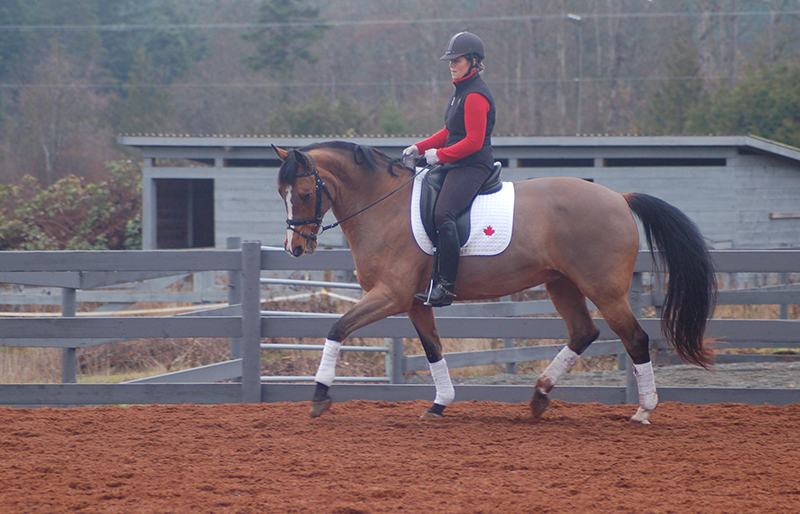
Photo: Darlene Brain
Once you are satisfied that you have achieved this, half-halt with your seat and close your hand (not pulling back on the reins), and ask the horse to come back (refer to Photo #2). You are not asking for collection, but merely trying to put the horse into a better state of balance, preparing him for the work ahead. This exercise can also be performed at the canter. While transitions within a gait are extremely beneficial, don’t overdo it. “Don’t always be doing something,” says Dueck. “Let the horse just go forward for a while.”
“Forward and back transitions test the first three qualities that I am looking for in my horses: the forward reaction to the leg, the forward connection to the bit, and the ability to balance the horse back a little towards his hind legs,” Dueck explains.
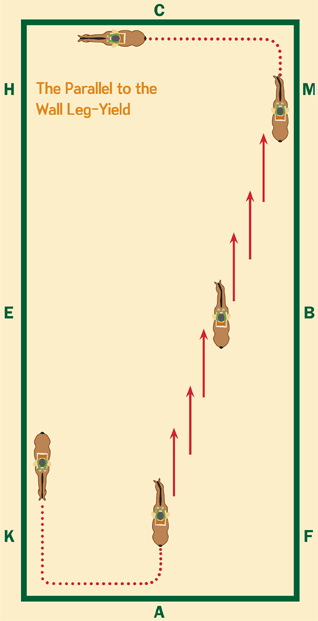
“Once these are achieved then longitudinal and lateral suppleness become more of a priority in my warm-up.” Longitudinal suppleness (roundness) is from poll to tail, not just in the neck, while lateral suppleness refers to bendability.
To encourage suppleness, “leg-yielding is the most important lateral exercise. It gets a response to your leg…it also supples and opens up the [horse’s] hips. You can feel their back open and loosen up with a good leg-yield,” Dueck says. “If you can do a good leg-yield, you have to maintain some balance, both longitudinally and laterally.”
There are many different leg-yielding exercises that you can do. Here are two of Dueck’s favourites:
The Parallel to the Wall Leg-Yield
Establish a forward, balanced, working trot to the left around the arena. At ‘A’ turn up the centreline and leg-yield off your inside (left) leg toward the right. You want to think about displacing the horse’s haunches with your inside leg which should be slightly back. Make sure that your horse is not falling out through his right (outside) shoulder and that you can half-halt and he will immediately respond. “Leg-yields, where the horse’s spine remains straight with a slight flexion to the inside, test that you’re able to half-halt with your outside rein,” says Dueck.
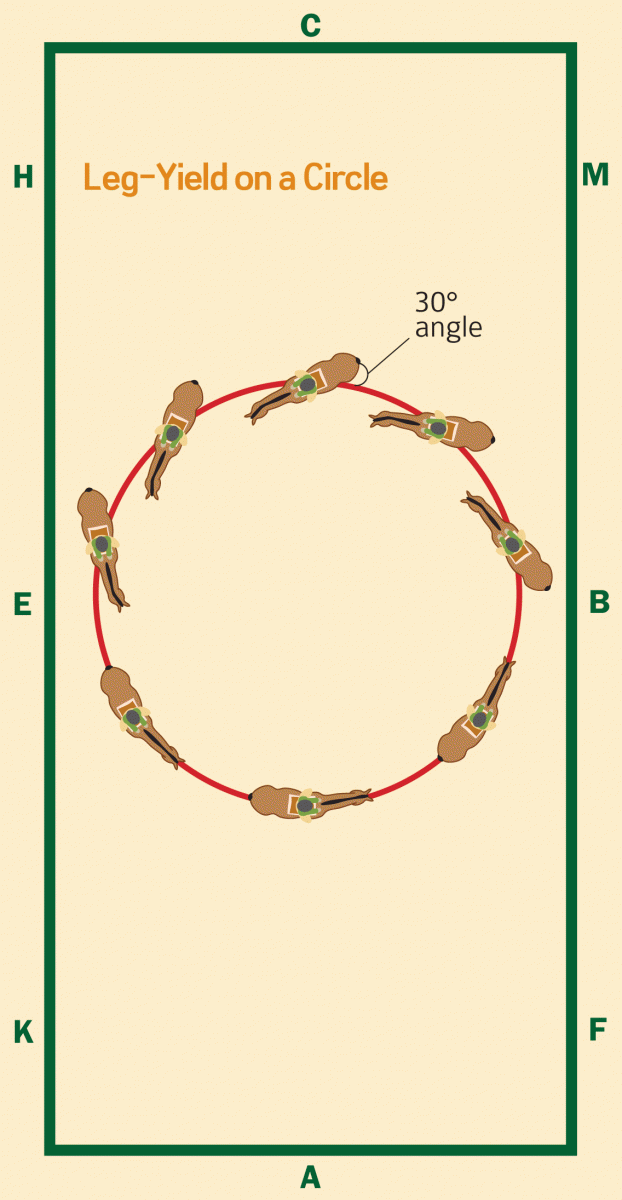
Leg-Yield on a Circle
Ride a 20 metre circle at ‘B’ and on the first half of the circle (from ‘B’ to ‘E’) ride working trot. On the second open half of the circle (from ‘E’ to ‘B’) straighten the horse’s spine and displace the horse’s haunches to the outside, with the shoulders remaining on the circle line. Again, you want to make sure that you can half-halt with your outside rein.
Dueck knows that her horse is ready to move on to more advanced work when “he is calm, sharp to my aids, I just think forward and he goes, a light leg and he goes sideways, he’s supple longitudinally, and I can make a transition forward or sideways and have it go through his body…then I take a walk break and then put it all together.”
EXERCISES FOR HUNTER/JUMPER AND EVENTING HORSES
Jane Stone is an EC Level 3 Eventing Coach based out of Cobble Hill, BC. She was long-listed to the Canadian Team in 1981 and has attended coaching seminars with prominent coaches including Jimmy Wofford, David O’Connor, and George Morris. Several of her students have ridden at the Intermediate level and competed on North American Young Riders teams.
Stone’s approach to warming a horse up for jumping begins in much the same way as her dressage warm-up, with approximately 10 minutes of forward, active walking on a loose rein. Next, she says, “I start in rising trot in a long, low, round frame, working big circles and serpentines.” Stone’s warm-up plan is also flexible based on the type of horse she is working with. “A lazy horse will benefit from using the entire arena where you can send him forward firmly on the long sides and across the diagonal.” On the other hand, “a hot or tense horse will usually settle more easily on a circle while incorporating spiralling in and leg yielding out.”

Spiralling in and Leg-Yielding Out on a Circle
Beginning on the left rein in trot on a 20 metre circle, spiral your horse in onto a 10 to 15 metre circle (depending on his level of training). Once you have established the correct bend and connection on the smaller circle, leg-yield back out to the 20 metre circle. Throughout the leg-yield you want to ensure that your horse is in true leg-yield, rather than drifting out through his outside shoulder. Maintain true contact and make sure that he moves easily off your inside (left) leg into your outside (right) rein. If he begins to fall out through his outside shoulder, cease the leg yield and ride a circle line to re-establish straightness before continuing. You should feel that he begins to sit back on his hindquarters and becomes softer in the bridle.
“After about 20 minutes or so of walk/trot/canter work [on the flat], I like to start work over trot and canter poles,” says Stone. “Even experienced horses benefit from this as it encourages suspension in the paces, obedience in maintaining the rhythm and balance (particularly over canter poles), and gets the rider focusing on an accurate line.”
“The poles should initially be set at a comfortable distance for the horse’s regular trot or canter stride, but then shortening and lengthening the distances will make the exercise more challenging.
One of Stone’s favourite pole exercises is poles set in a fan on a circle, which she says “really tests the accuracy of the line,” an important factor when jumping.

Poles on a Circle
Set three or four ground poles up in a fan pattern on a 20 metre circle. For the average horse, the distance from the centre of one pole to the next should be approximately four to five feet for single trot steps, and eight to nine feet for double trot steps. These distances may be adjusted as needed to accommodate your horse’s natural stride. Begin by trotting through the centre of the poles while maintaining the bend on the circle. Then, depending on what you are looking to school on a particular day, you can trot on an inside track through the poles to encourage your horse to shorten his stride, or on an outer track to develop lengthening in the trot. Maintain a light, steady contact from your legs and seat through the reins to the horse’s mouth and you should feel the horse’s back come up and into your seat.
Stone follows ground pole work with the over-fence portion of her warm-up by “trotting to a single fence with a placing pole about eight to nine feet in front…this simple exercise tells so much about the state of the horse and rider on any given day.”
Evaluating your horse’s rhythm, straightness, and attitude toward the obstacle can help you establish or modify your goals for the workout session ahead. For example, if your horse is behind the leg, you may want to go back to working on transitions to sharpen him up to your aids. Likewise, if he is not straight on the approach to the fence, perhaps some lateral work (ie. Shoulder-fore, leg-yielding, etc.) is called for before returning to the jumping.
Problems such as rushing, laziness, or crookedness are, according to Stone, “much easier to identify over a single trot fence and easier to fix early on before moving to more challenging jumps in canter. A horse might do two or twenty trot fences. [It depends on] however long it takes for the horse to settle into a relaxed, balanced trot coming in, jumping the fence calmly with straightness before, over, and after the fence, and a calm canter away from the jump. Only when this is achieved do I move on to the canter fences.”
Although we have broken the exercises down into discipline specific categories, each exercise has the potential to benefit horses and riders of all disciplines. For example, a dressage horse may profit from work over ground poles, while the above leg-yielding exercises can be modified to include side-passing.
Regardless of your discipline, riding level, and the breed and age of your horse, the goals of a warm-up are universal: to establish a relaxed, supple, obedient horse that is prepared physically and mentally to begin his workout session.



